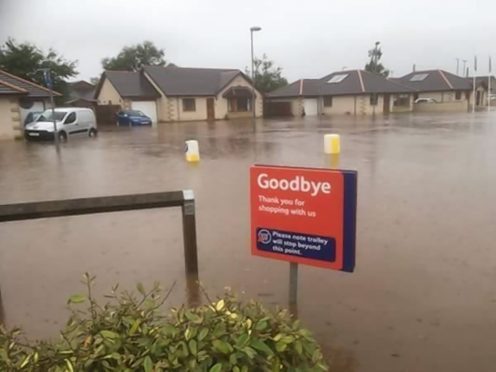A Moray family whose home has been flooded twice in two years faces a decade long wait for their house to be protected from further damage.
Neal and Claire Stewart, and their two young children, were driven from their Buckie property by rising waters in 2014 and 2016.
They say they now live in fear of the Fairway Road area becoming swamped every time there is heavy rainfall.
Following their latest ordeal last summer, they were told that flood defences could be installed to protect the area in 2019.
But Moray Council’s new management plan confirms it is likely that work to tackle the situation won’t be possible until between 2022 and 2028.
Last night, Mr Stewart said he felt “let down” by the latest development, and demanded the at-risk part of Buckie be treated as a priority.
He added: “We feel this is quite horrendous, we think we have been let down a bit here.
“The goalposts seem to have been moved, and we just don’t know where to turn.
“I appreciate the council has its own funding problems, that has been made clear to us.
“But this is a nightmare, we have enough to deal with in our lives without having to pursue this.”
Murky water engulfed the bottom floor of the Stewart’s home in Buckie after torrential rain caused a burn to burst its banks last June.
The floods rushed from the A942 road into the town, and also submerged the Tesco car park and petrol station.
Vulnerable residents at the Parklands Care Home, on High Street, grew “very worried” as they watched water fill its car park and edge towards the door of the building.
However, firefighters managed to pump water away from the premises before it seeped into the home.
The local authority has acknowledged the Buckie neighbourhood among a slew of 26 “hotspot” areas requiring action to prevent flooding.
Other parts of Moray included in the plans are Balnageith Farm near Forres, the Borough Briggs and Station Road areas of Elgin, Aberlour’s High Street, Keith’s Bridge Street and New Street in Rothes.
Documents state that, under the new scheme, the number of properties at risk from flooding and the average amount of damage caused will be reduced by 2027.
The report adds that the works will be prioritised “based on risk” with the number of properties affected and frequency of flooding being taken into account.
But the council’s acting consultancy manager, Debbie Halliday, told elected members that larger projects would be reliant upon central funding.
She said: “We need Scottish Government funding for any big projects, and they would go into the next cycle of flood risk management plans, which runs from 2022 to 2028.”
She said that less expensive works could possibly be covered by the council’s own revenue budget and put in place more speedily.
“If there are any quick hits, that we can cover from our own revenue budget, then we would look at doing them sooner than that”, she added.
Officers will now devise ways of tackling flooding in each of the identified problem areas before proceeding with the plans.
Speyside Glenlivet councillor, Pearl Paul, voiced fears that the 2022-2028 target date would leave concerned residents waiting “a long time” for an answer to their flooding fears.
Meanwhile, Scottish Water will work in partnership with Moray Council to develop an individual study for Forres which aims to tackle surface water issues there.
